[回上頁 | 顯示此文件為可列印格式]
此文件提供者: shuYing - [評分 : 0.00 (0 票選) | 評分!]
Swine breeding and genetics in
France
C. LEGAULT -
Institut National de la Recherche
Agronomique
Centre de Recherches de Jouy - Station
de Genetique quantitative et appliquee
78352 - JOUY en JOSAS Cedex - France
ABSTRACT
The pig population in France in
1991 numbered 12.1 million animals including 1.14 millions reproducing sows; it
produced about 22 million carcasses (average weight of 85.7 kg) corresponding to
89 % of the national consumption in pig meat (38 kg per capita).
The distribution of sows according
to (the) genetic type is as follows: crossbred Large White x Landrace (91 %),
Large White (5 %), French Landrace (2 %) and Pietrain (1 %). The distribution of
boars used in artificial insemination (35 ~k) on January 1st 1993 was: Large
White 8 %, French Landrace 7 %, Pietrain 15 %, Pietrain x Large White 33 ~k,
various composite and specialized terminal boars: 37 %. In natural mating the
proportion of pure Pietrain boars is very low.
The breeding animals are owned by 3
kinds of partnerships in the following proportion: independant pig breeders (10
%), breeding cooperatives (55 %) and breeding companies (35 9b). The national
breeding scheme deals with the first two. It is based on a combined performance
and sib testing procedure in national testing stations (3000 boars/year)
completed by an "on farm" performance testing program (70 000 animals/year). The
selection objective combines daily gain, feed efficiency, lean percentage,
dressing out percentage and meat quality. Moreover, comparisons of terminal
products from differents schemes (cooperative and breeding companies) are
regularly carried out.
A computerized field recording
program permits the analysis of the components of the sows' numerical
productivity (800 000 litter/year). On the basis of a selection index on litter
size, it has also enabled the selection at a so-called "hyperprolific strain of
boars" used in A.I. in the Large White breed.
Over the last 20 years, the average
annual genetic progress in the Large White breed has been estimated at near 8
g/year for daily gain; .03 kg/year for feed efficiency ratio and .35 points for
lean percentage. During the same period, a phenotypic yearly improvement of .3
pigs weaned/sow/year was observed in sows.
Estimation of breeding values by
means of Blup-animal model methodology will be implemented in 1993 for
production traits and in 1994 for reproduction traits. In the near furture, the
priority will be given to the genetic improvement of daily gain, meat quality
and litter size. Recently identified major genes (such as Haln, Rn-,
Mu+...), associated with advances in biotechnologies (PigMap), will
probaly present complementary garanties for success.
Swine breeding and genetics in
France
C. LEGAULT
Institut National de la Recherche
Agronomique
Centre de Recherches de Jouy
Station de gendtique quantitative
et appliquee
78352 JOUY-en- JOSAS Cedex - France
I -
INTRODUCTION
With 1.85 million tons produced in
1991, France is the 3rd largest pig meat producer in the European Community
(after Germany and Spain). In 1992, France has almost achieved self sufficiency
producing 89 % of its requirements (38 kg per capita). The pig population in
1991 numbered 12.1 million animals including 1.14 million saws producing about
22 millions carcasses averaging 85 kg.
Important structural changes in the
structures have led to greater specialisation on pig farms. In 1991, there were
145.000 pig farmers compared to 523.000 in 1974. At present, 80 % of all pigs in
France are in fact to be found in 10.000 herds of over 400 heads.
The majority of pig farmers breed
and fatten their stock. Pig keeping is confined t( certain regions, (figure 1):
In 1992, over 65 % of pigs produced in the country came from the "Bretagne" and
"Pays de Loire" regions. Since 1970, great progress was observed due to the
organization of production by the development of "Pig producers groups". Over 80
% of pig produced in 1992 come from these groups.
II -
GENERAL CONSIDERATIONS ON PIG BREEDING IN FRANCE
The breeding animals are owned by 3
categories of partnerships in the following proportions:
- Independent pig breeders:
10 %
- Breeding cooperatives: 55 %
- Breeding companies: 35 %
Over 80 % of breeding animals are
owned by less than 10 breeding cups (cooperatives or companies).
The national breeding program is
defined and managed by the national committee for animal breeding (commission
nationale d'amelioration genetique) created by the "animal breeding act" (1966).
The national breeding scheme deals with the individual; and cooperative pig
breeders directly. As will be described more in detail later, i) activity is
based on national testing stations, completed by an "on farm performance
testing" program and a computorized field recording program for reproductive
sows. Moreover, comparisons of "terminal products" from different schemes
(including breeding companies) are regularly carried out.
The use of artificial insemination
has increased very quickly during the last few years (35 % in 1993 compared to 5
% in 1988). In selection herds, this percentage is about 40 %.
The distribution of sows according
to the genetic type is as follows (figure 2a.) crossbred Large White x French
Landrace: 91 %; Large White: 5 %; French Landrace: 2 %; Pietrain: 1 %. The
distribution of boars used in artificial insemination was as follows on January
1st 1993; Large White: 8 %; French Landrace 7 %; Pietrain: 15 %; Pietrain x
Large White: 33 %; various composite and specialized terminal boars: 37 %
(figure 2.b.). In natural mating, the proportion of pure Pietrain boars is very
low.
Other breeds, including Duroc,
Chinese breeds, Creole, Corsican pig and native breeds (Gascon, Limousin,
Basque, Normand) represent well under 1 % of breeding animals.
In summary, (figure 3): the pig
industry is dominated by crossbreeding schemes (over 95 % of slaughtered pigs)
with a great homogeneity in the dam lines (F1 Large White x Landrace), and a
relative heterogenity in terminal sire lines; the overall distribution of
terminal boars (used in natural and artificial matings) is as follows: pure
breeds (essentially Pietrain): 12 %; Crossbred F1: {Pietrain x Large White;
Pietrain x Duroc etc...): 46 %; and composite specialized terminal boars: 42 %.
The proportion of this last category of boar is increasing.
III -
GENETIC IMPROVEMENT OF PRODUCTION TRAITS: GROWTH,
CARCASS AND MEAT QUALITY
The national breeding scheme is
based on a combined performance and sib testing procedure in 4 national testing
stations (3000 boars/year) completed by an "on farm" performance testing program
(75 000 animals/year). It is also completed by the on farm "Technico-economical
program (G.T.E.) managed by the "Institut technique du Porc" (DAGORN et al.,
1992). The selection objective combines daily gain, feed efficiency, lean
percentage, dressing out percentage and meat quality. Moreover, comparisons of
terminal products from differents schemes (cooperative and breeding companies)
are regularly carried out.
1. The national testing stations
A combined performance and sib
testing procedure has been used in the 4 national testing stations since 1987.
The purpose of this type of recording is to maintain meat quality at a constant
level. The principle is to link the performance of the potential breeding pig
with that of a full brother or sister (sib) which is slaughtered and cut up to
obtain information on body composition and meat quality. The performance figures
of both animals (the candidate to selection and its sib) are then combined
within a selection index including a constraint on meat quality. A theoretical
study shows that without 'constraint on meat quality, both methods (performance
testing and combined testing) lead to a significant deterioration of meat
quality due to unfavourable genetic correlations between meat quality and other
selected characters (daily gain and lean percentage). When meat quality is
constrained, the overall efficiency of the combined selection index is
satisfactory (+15 % compared to the reference situation). This is why it has
been decided to gradually replace individual testing by combined testing of
boars in France. The best selected boars are reserved in priority for the
artificial insemination centers.
The individual performance of young
boars registered in 1991 is reported in Table 1 and the slaughter performance
(growth, carcass and meat quality) of their collaterals compared to those of the
terminal products of different breeding schemes is reported in Table 2.
2. On farm pig recording program
The combined performance and sib
testing procedure in the national testing stations is completed by an "on farm"
performance testing program. As shown in Table 3, this programs which dealt with
over 75000 young boars and gilts in 1991, concerns mainly purebred animals
(Large White, Landrace and Pietrain) and also Pietrain x Large White young boars
selected for use as terminal boars. This program is managed by the "Institut
Technique du porc" (ITP), the young breeding animals being classified within
"control batch" on the base of a selection index combining 2 characters: the age
at 100 kg and the backfat thickness at 100 kg.
3. Elimination of the sensitivity
to halothane gene
The improvement of meat quality is
considered a priority in by the French pig industry. The elimination of the
sensitivity to halothane recessive gene responsible for P.S.E. also meat has the
advantage of reducing financial losses due to the stress syndrome with a
resultant mortality during the fattening period or transportations. In order to
reduce as far as possible the proportion of halothane sensitive fattening pigs
in commercial units, a decision was made in 1981 to eliminate the stress
syndrome from the French Landrace breed. Since Large White in France are almost
free from this unfavourable gene, it would be the same for the Fl Large White x
Landrace crossbred parental sows. Under these conditions, terminal products
would be normal in heterozygous or respect to stress sensitivity.
Under this scheme all young French
Landrace boars recorded in national performance recording stations since 1981
have been submitted to the Halothane test. The effectiveness of this breeding
scheme was increased in 1985 by the use of blood markers to enable pigs to be
presumed carrying only one sensitivity gene, i.e. the heterozygotes, to be
identified among animals not sensitive to, halothane (COUROT et al., 1989).
Blood markers used in France are
phosphohexose isomerase (PHI) and 6 - phosphogluconate dehydrogenase (PGD), the
electrophoretic variations of which at or near the loci are closely associated
with the sensitivity to halothane locus. The French Landrace has now joined the
Large White in respect of meat. quality characteristics recorded in national
stations, thus putting an end to a long series of results which gave the Large
White the reputation of produccing the highest quality meat {SAUGERE et al.,
1989). Commercial farmers, butchers and meat processors now find that at most
only 1-2% of fattening pigs are sensitive to halothane as a result of this
knowledge.
New advances are represented by the
use of molecular typing (FUJII et al., 1991; DALLENS and RUNAVOT, 1992) to
detect the heterozygous animals as well in maternal breeds (Large White,
Landrace ...) and in specialized sire lines.
4. The realised genetic progress
for production traits
Several estimates of the genetic
progress achieved through the national breeding program have been carried out
(TIXIER and SELLIER 1986; OLLIVIER et al., 1991; DUCOS et al., 1993). Hence,
over the last 20 years, the average annual genetic progress in the Large White
breed has been estimated at near 8 g/year for daily gain; .03 kg/year for feed
eKciency ratio and .35 points for lean percentage. Meat quality is the only
trait for which a slight but regular decrease was observed. These genetic
variations are illustrated for the Large White and French Landrace breeds by the
Figure 4 (DUCOS et al., 1993). An other example of this change under field
conditions for different measures of feed conversion ration is illustrated by
figure 5 (DAGORN et al., 1992).
5. Two major genes influencing
production traits
Recent advances in French pig
research have lead to the identi6cation of two major genes influencing meat
quality (Rn- ) and backfat thickness (MU+) respectively.
The hypothesis of NAVEAU (1986)
concerning the low pH (acid meat) and low technological yield was confirmed by
research workers utilising a segregation analysis method (LE ROY et al., 1990).
The effect of this gene is particularly important since the difference between
homozygotes represents about 3 standard deviations in technological yield; its
frequency was probably relatively high in the Hampshire breed ("Hampshire
effect"). An experiment is being developed to specifically study this gene. Pig
breeders have also decided to eliminate this gene.
Another dominant gene influencing
backfat thickness was identified by LE ROY et al. (1990). The difference between
homozygotes corresponds to 2 phenotypic standard deviation in backfat thickness.
A more precise genetic study of this gene has also been decided.
Ⅳ. THE
IMPROVEMENT OF REPRODUC PERFORMANCE
Litter size is considered to be the
most important component of the sows' numerical productivity defined as the
number of pigs weaned/sow/year (Pn) parameter which determines the cost of the
piglet at weaning. However, litter size is particularly difficult to improve
through usual selection methods because of its low heritability and its low
repeatability. In this review, we will point out specific aspects of the French
strategy regarding the improvement of sow productivity:
- A large scale computorized
program.
- The selection of "hyperprolific
strains of boars.
- The creation of Chinese-European
composite maternal lines.
1. The computorized field recording
of sow performance
The objective of the "National Sow
Herd Management Programme" (GTTT), which was instituted in 1969, is to improve
the numerical productivity of herds. This objective can be achieved by taking
into consideration the various criteria recorded which make up overall
productivity. This program is used by nearly 6.000 farmers (selectioners,
multiplyers and producers). The figures represent a national data bank available
for breeding and various comparisons.
These data are used as the basis
for selecting sows according to prolificacy and regularity of breeding. Annual
records, calculated for a twelve month period, contain the events which occurred
in the herd during the last twelve months and in a reference group.
The main results are listed in
Table 4 for pure breeds in 1991. The overall results observed in 1992 are listed
in Table 5. This sample of nearly 900.000 litters represents 37 % of all litters
born in France in 1992.
As will be developed later, this
program is used to derive the sow prolificacy indexes. This enables
hyperprolific sows to be identified to assist the national programme of creating
hyperprolific lines. It also enables hypoprolific boars to be identified; these
may be carrying chromosome anomalies.
The variations from 1970 to 1992 of
the main reproductive performances of sows are represented on figure 6a for
litter size (total born, born alive and weaned/litter), on figure 5b for
lactation length and weaning-fertilization interval and on figure 6c two
estimates of the numerical productivity. Over the last 20 years, an average
phenotypic yearly improvement of .3 piglet weaned/sow/year has been observed.
2. The "Hyperprolific" strains of
boars
French saws already have the
reputation of being among the most productive in Europe (22.6 piglets weaned per
sow per year in 1992. This figure is explained by:
– The high level of prolificacy: an
average of 11.5 total piglets born and 9.4 piglets weaned per litter;
– intensive breeding – an average
of 2.37 litters per sow per year, the result of an average farrowing interval of
153.6 days.
However, this productivity from sow
herds should improve by 5-10 % in the next twenty years as a result of the
development of a new method of selection, the hyperprolific method. The
principle for the creation of a hyperprolific line which was explained for the
first time in 1976 by LEGAULT and GRUAND is based on two key factors:
- Screening of sows with
exceptionnal prolificacy (selection rate ranging from .2 to .5 %).
- The practice of successive
back-crossing on this nucleus of exceptional sows which enables boars to be bred
with a genetic value for prolificacy which tends to be asymptotically similar to
that of their dams, after 3 or 4 generations (Figure 7). This principle has been
applied by INRA to the Large White breed in order to create an experimental
hyperprolific line of boars used in A.I.. The theory of the use of this line was
tested in two evaluation trials in which the reproductive performance of the
daughters of boars of the hyper line was compared with that of contemporary sows
sired by control boars. In the first evaluation trial by LE ROY et al., 1987,
daughters of hyper boars showed an advantage over their contemporaries of + 0.99
and + 0.88 piglets born and piglets born alive, respectively. More recently, a
second trial confirmed the above results with advantages of + 0.73 and + 0.60
piglets born and piglets born alive per litter respectively.
The results presented above show
that it is possible to obtain genetic progress conforming to theoretical
forecasts on an as low a heritable trait as litter size, under three conditions:
- Using a
computerized selection method for extreme animals within a very large
population.
- Resorting to
artificial insemination.
- Showing a collective spirit
enabling the pooling of genetic potential of the greatest number of breeding
stock possible.
However, this simple method,
relying for effectiveness on an extremely rigorous selection rate (less than 1
%) and the distribution capacity of A.I., should improve tremendously very
shortly: using the BLUP – an animal model which takes account of the information
available on all collaterals will bring a considerable improvement to accuracy
in screening exceptional animals. In addition, the situation is confirmed by the
expansion of A.I. which multiplies the "genetic connections" between herds.
During these last few years, French
professionals have become more and more interested in developing and using
hyperprolific lines in the Large White and French Landrace grandparent female
breeds. It was to regularise this situation that the Ministry of Agriculture
draped rules with the consent of INRA and ITP. According to these rules, a Large
White boar is granted hyperprolific status when its prolificacy index exceeds or
is equal to 110 (threshold corresponding to 2.5 standard deviations above the
average for the breed). In the Landrace, this threshold is 108 (2 standard
deviations). At the beginning of 1993, 25 Large White boars and 6 Landrace boars
meeting this quali6cation were in service in French artificial insemination
centres.
3. Reciprocal translocations in the
pig: detection, eradication and prevention
Reciprocal translocations are the
most studied structural chromosomic abnormalities in the pig due to their
desastrous effects on reproduction. Indeed, the size of the litters produced by
breeding animals bearing such an abnormality is reduced by 40 % to 50 % due to
embryonic mortality at implantation. As a consequence, the yearly economic loss
of a translocated boar ranges from 30.000 FF to 50. 000 FF in natural mating and
10 to 15 times more in artificial insemination (Al). Thirty of the 50 or so
translocations presently described in the pig were discovered in two countries,
Sweden and France, POPESCU (1990). Fortunately, the frequency of translocations
is relatively low (about 1/1500).
Any breeding animal producing small
litters may be suspected to carry a translocation with a probability depending
on the quality and the precision of the available information. The principle and
efficiency of the detection of reciprocal translocations through a computerized
field screening system are discribed (LEGAULT and POPESCV, 1993). In France,
such a screening program enabled the detection of about 40 "hypoprolific boars"
per year, 40 % of which carried a translocation, as subsequently revealed by
caryotype analyses.
A screening system which includes
all hereditary abnormalities and based on the examination of the 20 first
litters produced by AI boars is proposed. This method should involve the
material and financial participation of AI centers.
4. Chinese crossbred animals: a new
opportunity
On the basis of an estimation of
Dickerson's crossbreeding parameters between Meishan and Large White breeds,
LEGAULT and BIDANEL (1992) discusses several strategies for taking advantage of
prolific Chinese breeds as maternal components in crossbreeding schemes under
different production systems. In fact, Chinese breeds could play an active part
in the improvement of the efficiency of the pig industry as suggested by recent
development of research and breeding projects in an increasing number of
ceuntries. Among different possible strategies for taking advantage of prolific
Chinese breeds in various market conditions, the creation of composite lines
selected in favour of growth and body composition seems to be by far the most
promising.
A first illustration of this
theoretical expectations is given by the results of 8 generations of selection
for lean growth rate in a sino - european composite line (NAVEAU et al., 1992;
Figure 8): lean content has been improved by almost 10 points %; litter size
decreased between generations 1 and 2 (due to the loss of half of the maternal
heterosis effect) but remain rather constant from generations 2 to 7. (The
composite line exhibits a superiority of 2.6 pig weaned per litter over the
european foundation breed).
V -
PROSPECTIVE ASPECTS
The general objective of research
carried out by the pig unit of the INRA Quantitative and Applied Genetics
Station (SGQA) at Jouy - en - Josas is the study of hereditary transmission and
methods of genetic improvement of quantitative characteristics with an economic
nature in the pig meat production. This involves the development of optimum
breeding programmes, the testing of new selection criteria and the evaluation of
different genetic material (pure breeds and crossbreds). The work is based on
information collected on farms or from National Breeding Stations and from
experiments conducted on INRA herds. Other laboratories of the IKRA Department
of Animal Genetics are also involved in pig research, principally in the field
of chromosome abnomalities, genetic map, immunogenetics (SLA major
histocompatibility complex) and molecular biology.
Producing quality pigs at the
lowest possible cost will remain the main goal of pig breeders in the near
future. However, some changes in the priorities due to the decrease of the price
of cereals on the world market and due to the french grading system of carcasses
(figure 9). Thus, the priority will be given to the genetic improvement of daily
gain, meat quality and litter size. Estimation of breeding values by means of
Blup-animal model methodology will be implemented in 1993 for production traits
and in 1994 for reproduction traits. Recently identified major genes (such as
Hal, Rn-, Mu+ ...), associated with advances in
biotechnologies (PigMap), will probably present complementary guarantees for
success.
Concerning reproduction, it seems
obvious that pig breeding professionals will no longer be content in the future
with grandparent female lines which, in terms of reproduction, are of constant
level. It has been be shown that the Large White is likely to progress fairly
rapidly for prolificacy and that this progress can be added to the effect of
heterosis in crossbreeding. If, for the moment, the limiting factor remains the
Large White sows' ability to rear large litters up to weaning, there are
nevertheless great hopes with the forthcoming arrival on the market of composite
Sino-European lines, which are expected to partner the prolific Large White
lines at grandparent female level.
REFERENCES
BIBLIOGRAPHIQUES
COURREAU J.F., SELLIER P., BOULARD J.,
BRETON T., GOULLIEUX P., GUERIN G., 1985. Marqueurs sanguins (Phi et Pgd) et
sensiblitb h l'halothane chez le porc Landrace Franglais. Journdes Rech. Porcine
en France, 17, 95-104.
DAGORN J., BADOUARD B., LEGAULT C.,
1992. Performance control of pig farms in France. From technical support to
national data banks. Satellite Symposium on: Pig management information systems,
Madrid, Espagne, 12 september 1992, 1-10, European Association for Animal
Production, Commission in Pig Production.
DALENS M., RUNAVOT J.P., 1993. Test
moleculaire pour le d4pistage du one de la sensibilite a l'halothane chez le
porc. Techniporc. 1993-1, 17-21.
DUCOS A., BIDANEL J.P., BOICHARD D.,
DUCROCQ V., 1993. Nouvelle estimation des parametres genetiques pour les
caractkres de croissance, carcasse et qualite de la viande dans les races Large
White et Landrace Franglais. 1. Caract0res mesures dans les stations publiques.
(New estimation of genetic parameters for growth, carcass and meat quality
traits for the Large White and French Landrace pig breeds. 1. Traits recorded in
central stations.) 256mes Journdes de la Recherche porcine en France, Paris, 2-4
fevrier 1993, 43-50, ITP, Paris.
FUJII J., OTSU K., ZORZATO F., DE LEON
S., KHANNA V.K, WEILER J., O'BRIEN P.J., MACLENNAN D.H., 1991. Identificaiton of
a mutation in porcine ryanodine receptor associated with malignant hyperthermia.
Science, 253: 448-451.
LE ROY Pascale, LEGAULT C., GRUAND J.,
OLLIVIER L., 1987. Heritabilite realisee pour la taille de portee dans la
selection de truies dites "hyperprolifiques". (Realized heritability for litter
size in selection of "hyperprolific" sows.) Genet. Sel. Evol., 19, 351-364.
LE ROY P., ELSEN J.M., NAVEAU J.,
1990. Etude de la variabilite genetique de 1'adiposite dans la lignee Laconic.
(Study on genetic variability of fatness in the Laconic line.) 22emes Journees
de la Recherche porcine en France, Paris, 30-31 janvier et ler fevrier 1990,
11-16, ITP, Paris. (Ann. Zootech., 39, 139-140, res. + abstr.)
LE ROY P., NAVEAU J., ELSEN J.M.,
SELLIER P., 1990. Evidence for a new major gene influencing meat quality in
pigs. (Mise en evidence d'un nouveau gene majeur influant sur la qualite de la
viande de porc.) Genet. Res., 55, 33-40.
LEGAULT C., GRUAND J., 1976.
Amelioration de la prolificite des truies par la creation d'ye lignite
"hyperproli6que" et 1'usage de 1'insdmination artificielle: principe et
r6sultats expdrimentaux prdliminaires. Journees de la Recherche porcine en
France, Paris, fevrier 1976, 201-206. (Ann. Zootech., 25, 445, res. angl.).
LZGAULT C., BIDANEL J.P., 1992.
Overall review of genetical research on Chinese pigs in France and prospects for
exploiting Chinese crossbred animals. (Revue d'ensemble des recherches en
g4nbtique sur les pores chinois en France.) Proceedings of the International
Symposium on Chinese pig breeds, Chen Runsheng (Ed.), Harbin, China, August
11-14, 1992, 10-23, Northeast Forestry University Press, Harbin, China.
LEGAULT C., POPESCU C.P., 1993. Les
translocations r6ciproques chez le porc domestique: detection, eradication et
prevention. (Reciprocal translocations in the pig: detection, eradicatian and
prevention.) Elevage et Insemination, nº 254, 1-12.
NAVEAU J., 1986. Contribution 5
1'6tude du ddterminisme gdn4tique de la quality de viande porcine. Hdritabilit4
du Rendement Technologique Napole. In 18hme Journ4es de la Recherche Porcine en
France, pp.265-276. Paris: Institut Technique du Porc.
NAVEAU J., DUCOS A., BIDANEL J.P.,
BAZIN C., 1992. Results on eight generations of selection for lean growth rate
in the Sino-European Tiameslan composite line. Proceedings of the International
Symposium on Chinese pig breeds, Chen Runsheng (Ed.); Harbin, China, August
11-14, 1992, 632-637, Northeast Forestry University Press, Harbin, China.
OLLMER L., LAGANT H., GRUAND J.,
MOLENAT M., 1991. Progres g0ndtique des pores Large White et Landrace franglais
de 1977 a 1987. (Genetic
progress in French Large White and Landrace pigs from 1977 to 1987.)
23emes Journdes de la Recherche
porcine en France, Paris, 389-394, ITP, Paris. (Ann. Zootech., 40, 348-349 (res.
abstr.))
POPESCU C.P., 1989. Cytogenetique des
mammiferes d’elevage. (Cytogenetics of farm animals.) Institut National de la
Recherche Agronomique, Paris, 114 pages.
SAUGERE D., RUNAVOT J.P., SELLIER P.,
1989. Un premier bilan du programme de selection contre le gene de sensibilite a
1'halothane chez le porc Landrace Franc,ais. (First results of the breeding
programme implemented for decreasing the frequency of the halothane sensitivity
gene in the French Landrace breed.) 21emes Journees de la Recherche porcine en
France, Paris, 31 janvier, 1 et 2 fdvrier 1989, 335-344, ITP, Paris. (Ann.
Zootech., 38, 201, abstr.)
TIXIER Michele, SELLIER P., 1985.
Evolutions genetiques des performances de croissance et de carcasse dans les
races porcines Large White, Landrace francais et Landrace beige. (Genetic trends
for growth and carcass traits in the Large White, French Landrace and Belgian
Landrace pig breeds.) 17emes Journees de la Recherche porcine en France, Paris,
30-31 janvier et ler fevrier 1985, 75-86, ITP, Paris. (Ann. Zootech., 34,
362-363, abstr.) (Techni- Porc, 8 (6), 59-60, res. fr.)
Table 1:
Performance of young boars collected in the French national testing stations in
1991.
|
Character |
Large White |
French Landrace |
Belgium Landrace |
Pietrain |
|
Number
of boars |
1781 |
876 |
45 |
422 |
|
Age at
35 kg (d) |
82.2 |
82.6 |
99.1 |
90.2 |
|
Age at
90 kg (d) |
142.0 |
144.3 |
167.7 |
161.1 |
|
Av.
daily gain (g) |
928 |
898 |
789 |
764 |
|
Feed
efficiency ratio (kg) |
2.365 |
2.463 |
2.580 |
2.477 |
|
Back
fat thickness (mm) |
10.8 |
11.2 |
10.2 |
7.6 |
Table 2:
Slaughtered performance collected in French national testing stations in 1991
|
|
Large White |
French Landrace |
Pietrain |
Terminals |
|
Number
of pigs |
967 |
535 |
138 |
479 |
|
Average
daily gain (g) |
911 |
877 |
761 |
859 |
|
Feed
efficiency ratio (kg) |
2.81 |
3.01 |
- |
2.79 |
|
Age at
slaughter(day) |
155 |
156 |
169 |
159 |
|
Weight
at slaughter(kg) |
100.8 |
100.0 |
95.0 |
101.0 |
|
Dressing out (%) |
79.2 |
78.2 |
81.5 |
79.7 |
|
Estimated lean (%) |
52.8 |
51.0 |
63.1 |
55.1 |
|
Subjective meat quality score |
11.0 |
11.6 |
4.0 |
9.9 |
|
Water
holding capacity |
9.7 |
9.9 |
3.4 |
8.3 |
|
Reflectance |
586 |
569 |
670 |
589 |
|
pH 24h.
(Adductor femoris) |
5.88 |
5.96 |
578 |
5.83 |
|
Meat
quality index |
10.8 |
11.5 |
8.5 |
10.2 |
Table 3:
Results of the "on farm" national performance testing program in 1991.
|
Breed |
Sex |
Number of animals |
Number of testing
groups |
Weight at control
(kg) |
Age at
100 kg |
Backfat thickness at 100 kg |
|
Large
White |
M |
13465 |
410 |
100 |
146 |
11.6 |
|
|
F |
28813 |
652 |
96 |
154 |
12.8 |
|
French
Landrace |
M |
7549 |
251 |
98 |
151 |
12.4 |
|
|
F |
14571 |
336 |
93 |
158 |
13.3 |
|
Pietrain |
M |
2457 |
51 |
96 |
171 |
6.7 |
|
|
F |
2105 |
57 |
92 |
172 |
7.5 |
|
Pietrain x LW |
M |
10874 |
365 |
100 |
158 |
9.6 |
M: Males; F:
Females
Table 4: Reproductive performance of
pure bred sows in French in 1991
|
Criteria |
Large White |
French Landrace |
Belgium Landrace |
Pietrain |
|
Number
of Litters |
12.306 |
5306 |
286 |
938 |
|
Number
of Farms |
78 |
36 |
5 |
10 |
|
Farrowing interval (days) |
154.9 |
156.3 |
170.2 |
162.8 |
|
Lactation duration (days) |
28.7 |
28.1 |
34.2 |
33.7 |
|
Weaning-fertilization interval (days) |
11.1 |
12.9 |
20.0 |
13.2 |
|
Litter size |
Born alive |
10.4 |
10.1 |
9.1 |
9.8 |
|
Still born |
0.8 |
0.7 |
0.5 |
0.9 |
|
Weaned |
8.9 |
8.7 |
8.0 |
8.0 |
|
Age at
first farrowing |
358 |
351 |
379 |
374 |
|
Number
pig weaned/ sow/
year |
21.0 |
20.8 |
17.2 |
17.9 |
Table 5: Reproductive performance of
French sows in 1992: (90 % of these sows are crossbred Large White x French
Landrace).
|
Number of litters: 893.602
Number of farms: 6.777 |
Mean Value
 |
Between-farm
standard deviation
SF |
|
Number
of pigs weaned / sow / year (reproductive life) |
22.4 |
2.3 |
|
Number
of pigs weaned / sow / year
(from
200 days of age to the last weaning) |
21.6 |
1.9 |
|
Liter size |
born alive |
10.8 |
0.8 |
|
still born |
0.7 |
0.4 |
|
weaning |
9.4 |
0.8 |
|
Mortality rate (weaned/total
born) |
17.8% |
5.7 |
|
Lactation duration (days) |
27.3 |
2.7 |
|
Farrowing interval (days) |
153.6 |
12.0 |
|
Weaning-fertilization interval (days) |
11.2 |
11.6 |
|
Number
of litters weaned at culling |
4.6 |
1.4 |
|
Figures 1: Distribution
of pigs in France
(in % of total population- source: ITP 1992)
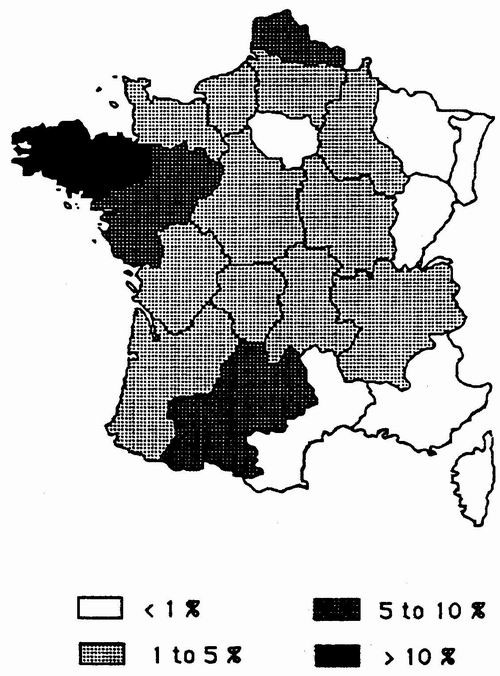
|
|
Figures 2a: Distribution of reproductive sows in France in 1992
 |
|
Figures 2b: Distribution of boars used in French A. I centers in
1992
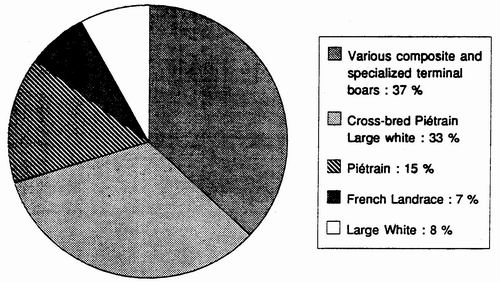 |
|
Figure 3: the most common cross-breeding scheme used in France

|
| Figure 4: Estimated genetic trends in French Large
White and Landrace breeds from 1977 to 1990 (Ducos & Bidanel, 1993) |
|
Fig 1. Mean predicted breeding values of average daily gain (ADG) by
year of birth for Large White and Landrace pigs.
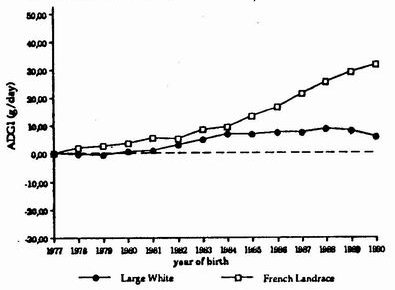 |
Fig. 2. Mean predicted breeding value for backfat thickness (ABF) by
year of birth for Large White and French Landrace pigs.
 |
|
Fig. 3. Mean predicted breeding values of feed conversion ratio (FCR)
by year of birth for Large White and French Landrace pigs.
 |
Fig. 4. Mean predicted breeding values of dressing percentage (D%)
by year of birth for Large White and French Landrace pigs.
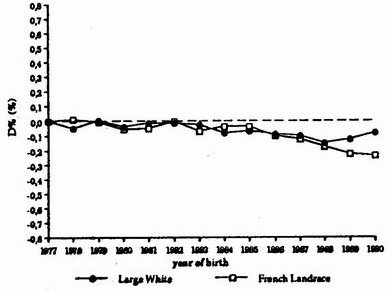 |
|
Fig. 5. Mean predicted breeding values of lean content (ECL%) by
year at birth for Lange White and French Landrace pigs.
 |
Fig. 6. Mean predicted breeding values of meat quality index (MQI)
by year of birth for Large White and French Landrace pigs.
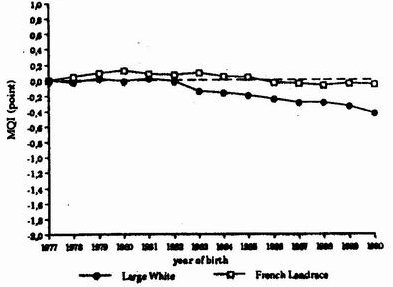 |
|
Figure 5: variation of feed conversion ratio from 1977 to 1991 in
France
 |
|
Figure 6a: variation of number of piglets born (PB), born alive (PBA)
and weaned (PW) per litter from 1970 to 1992 in France
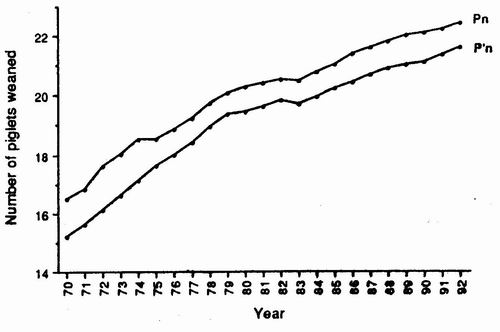 |
Figure 6b: variation of lactation duration (LD) and weaning
fertilisation interval (IWF) of sows from 1970 to 1992 in France
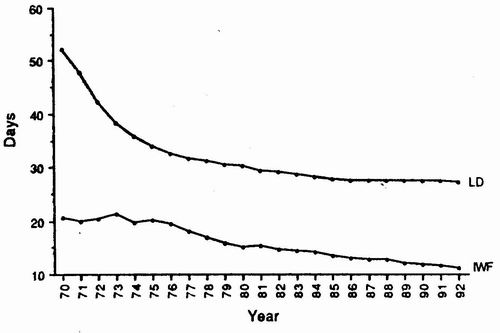 |
|
Figure 6c: variation of number at piglets weaned / sow per year of
reproductive life (Pn) and per year of presence on the farm (P'n)
from 1970 to 1992 in France
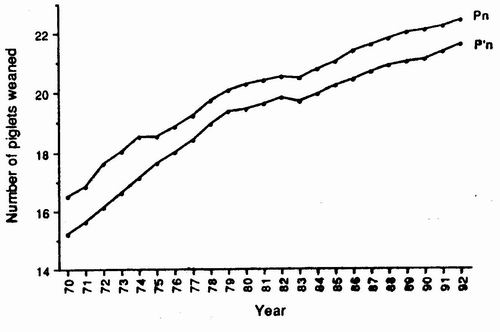 |
|
Figure 7a : illustration of the creation of a hyperprolific line 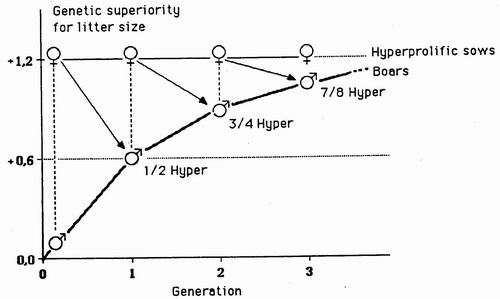
|
|
Figure 7b : mean of
cumulated selection differentials (S) of “hyperporlofic” boars
by year (between brackets :
number of boars)
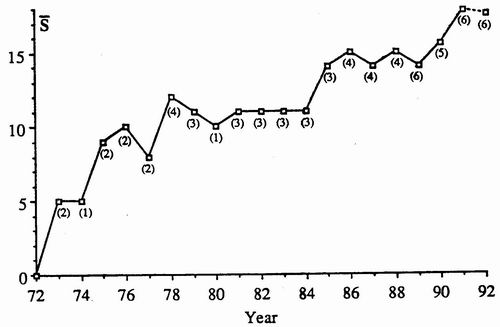
|
|
Figure 8: variation of age at 100 kg and carcass muscle percentage
through generations in the Tiameslan line (Naveau et al., 1992)
 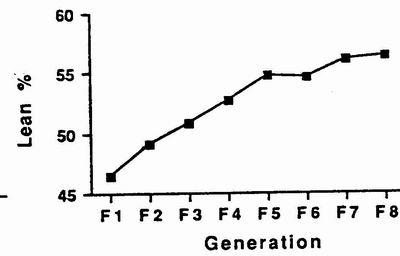 |
|
Figure 9: French grading system in terms of estimated lean % in carcass |
[回上頁 | 顯示此文件為可列印格式]
此文件提供者: shuYing - [評分 : 0.00 (0 票選) | 評分!]